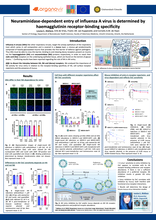Neuraminidase-dependent entry of influenza A virus is determined by haemagglutinin receptor- binding activity
In order for Influenza A viruses (IAVs) to infect the airway epithelium of the respiratory tract, the virus needs to overcome the mucus layer, a viscous gel predominantly comprised of heavily- glycosylated mucins, to access the underlying epithelial cells and its functional sialic acid (SIA) receptors. To achieve this, IAVs employ a two-step process involving the surface proteins haemagglutinin (HA) and neuraminidase (NA). HA is responsible for binding to SIAs, while NA cleaves decoy receptors present on mucins, a necessary step for the virus to reach its destination. However, previous scientific literature has presented conflicting findings regarding the significance of NA activity in the IAV entry process. To address this, Louisa aims to unravel the interplay between HA, NA and decoy receptors in the larger context of cell surface receptor diversity and mucus presence. By utilizing recombinant viruses that differ in both their HA and NA or HA only, she unveiled a link between the presence of α2-6-linked SIAs on host cells and the susceptibility of viruses to inhibition by the NA-specific inhibitor Oseltamivir. Viruses targeting α2-6-linked SIAs were found to be less inhibited by Oseltamivir when host cells expressed higher levels of these specific sialic acids. This insight could have profound implications for the development of future antiviral therapies.
| File | Type | Size |
|---|---|---|
| poster568.pdf | Adobe Portable Document Format | 1.5 MB |
